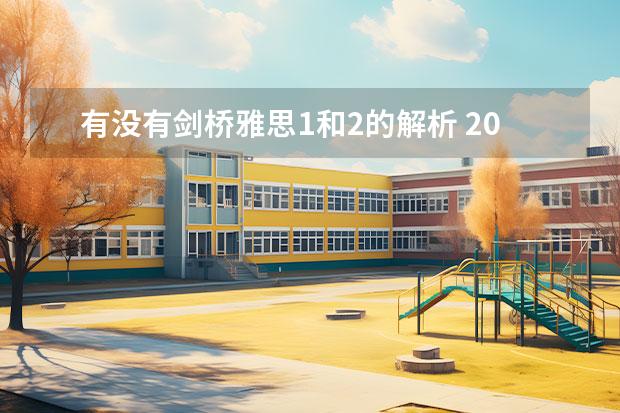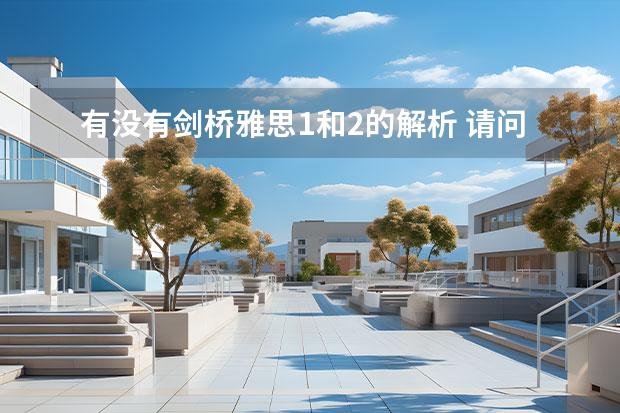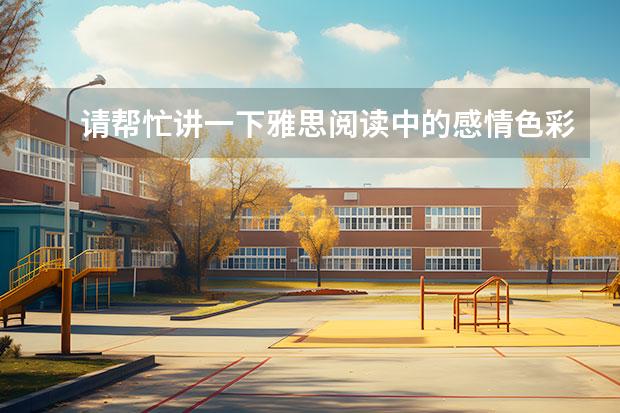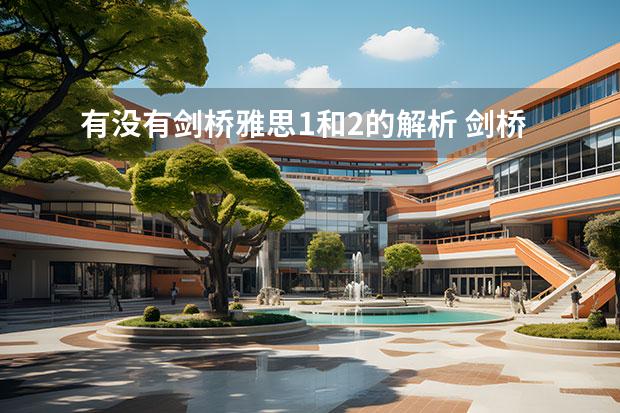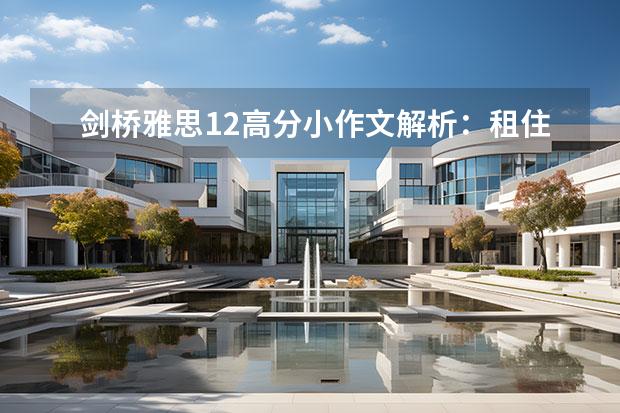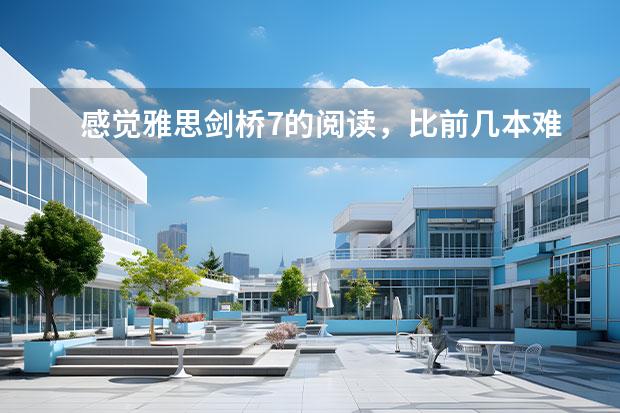今天金博宝188官网小编整理了有没有剑桥雅思1和2的解析 2023年1月6日雅思阅读真题回忆解析相关信息,希望在这方面能够更好的大家。
本文目录一览:

有没有剑桥雅思1和2的解析
洛阳大华雅思为您解答:《剑桥12》新鲜出炉,相信不少同学已经搓着小手坐等口语新题。
今天咱们先对4套题目进行整体归纳,分析出题动向:
Part1
1
Health
健康饮食及资讯、病后康复、生活方式
2
Songs and singing
唱歌的爱好、爱听的歌、音乐文化
3
Clothes
购物场所及频率、挑选方式、喜好变化
4
Art
绘画爱好、艺术展览、喜爱的画作
Part1分析
我们不难发现Part1的题目着眼于“日常习惯”和“艺术爱好”两大部分, 其中health与clothes着重于探讨同学们日常的饮食习惯、购物方式; 而song and singing与art则着重于交流大家的艺术爱好(特长)。
在此, Sunny希望大家能够对领悟到《剑桥12》给大家的提示: 其实日常话题中,foods、mirror、reading、cooking等等话题都属于日常习惯这一大类, 都要在考前做好练习; 而dance、color、history、swimming等等话题则与艺术爱好、历史文化互为关联, 必须重视!
Part2
Part3
1
Describe an occasion when you had to wait a long time for someone or something to arrive. 漫长的等待
·Arriving early
·Being Patient
2
Describe a film/movie actor from your country who is very popular. 著名影星
·Watching movies
·Theatre
3
Describe an interesting discussion you had about how you spend your money. 谈论花钱
·Money and young people
·Money and society
4
Describe a time when you visited a friend or family member at their workplace. 工作场所探访亲友
·Different kinds of workplaces
·The importance of work
Part2&3分析
这4套题从题型比例上来说,与以往有巨大的区别! 除了一道关于 “著名影星”的话题属于人物类,其余三道题——“漫长的等待”、“谈论花钱”、“探访亲友”——均属于事件类!因此2017年下半年,同学们的练习重心必须要着重于素材积累, 对于事件的描述也必须加深功力!其实《剑桥12》的这4道题,对于保持刷题的同学而言并非完全陌生:
“等待”这个话题实际上已作为考前必练题,也是每月预测题中经常上榜的话题,目前看来还会继续作为事件类的重点题型, 需要大家准备好素材,多从日常中需要等待的经历中挖掘;
“著名影星”其实可以跟之前练习过的“喜爱的电影”和“钦佩的名人”关联在一起,素材上结合目前闻名的影视明星,需要注重对人物品质和特点进行深入刻画。
关于“讨论”和“花钱”,考场上已经出现过的真题包括“有趣的谈话”、“花钱较多的活动”和“省钱的好方法”,在素材方面,这三个话题的语料其实拆解细节,再灵活运用于这道题目上;
而在“工作场所”进行“亲友探访”的话题上,我们能够感受到一丝地点类话题的气息,但它实际上更多是希望我们探讨人物与其工作的关系。同学们是否能够想起“Describe a person who can do well in work”以及“Describe a person whose job is important to the society”这两道题呢?其实如果把我们善于描述的努力工作的人物形象抽离出来,结合具体的工作环境展开描述,这个话题的思路其实可以很简单。
剑桥雅思阅读AUSTRALIA’SSPORTINGSUCCESS及答案解析
做好雅思的阅读题除了掌握对的 方法 ,也离不开我们日常的辛勤练习,下面我给大家带来剑桥雅思阅读AUSTRALIA’S SPORTING SUCCESS及答案解析,一起加油吧!
剑桥雅思阅读AUSTRALIA’S SPORTING SUCCESS
READING PASSAGE 1
You should spend about 20 minutes on Questions 1-13, which are based on Reading Passage 1 below.
AUSTRALIA’S SPORTING SUCCESS
A They play hard, they play often, and they play to win. Australian sports teams win more than their fair share of titles, demolishing rivals with seeming ease. How do they do it? A big part of the secret is an extensive and expensive network of sporting academies underpinned by science and medicine. At the Australian Institute of Sport (AIS), hundreds of youngsters and pros live and train under the eyes of coaches. Another body, the Australian Sports Commission (ASC), finances programmes of excellence in a total of 96 sports for thousands of sportsmen and women. Both provide intensive coaching, training facilities and nutritional advice.
B Inside the academies, science takes centre stage. The AIS employs more than 100 sports scientists and doctors, and collaborates with scores of others in universities and research centres. AIS scientists work across a number of sports, applying skills learned in one — such as building muscle strength in golfers — to others, such as swimming and squash. They are backed up by technicians who design instruments to collect data from athletes. They all focus on one aim: winning. ‘We can’t waste our time looking at ethereal scientific questions that don’t help the coach work with an athlete and improve performance,’ says Peter Fricker, chief of science at AIS.
C A lot of their work comes down to measurement — everything from the exact angle of a swimmer’s dive to the second-by-second power output of a cyclist. This data is used to wring improvements out of athletes. The focus is on individuals, tweaking performances to squeeze an extra hundredth of a second here, an extra millimetre there. No gain is too slight to bother with. It’s the tiny, gradual improvements that add up to world-beating results. To demonstrate how the system works, Bruce Mason at AIS shows off the prototype of a 3D analysis tool for studying swimmers. A wire-frame model of a champion swimmer slices through the water, her arms moving in slow motion. Looking side-on, Mason measures the distance between strokes. From above, he analyses how her spine swivels. When fully developed, this system will enable him to build a biomechanical profile for coaches to use to help budding swimmers. Mason’s contribution to sport also includes the development of the SWAN (Swimming Analysis) system now used in Australian national competitions. It collects images from digital cameras running at 50 frames a second and breaks down each part of a swimmer’s performance into factors that can be analysed individually — stroke length, stroke frequency, average duration of each stroke, velocity, start, lap and finish times, and so on. At the end of each race, SWAN spits out data on each swimmer.
D ‘Take a look,’ says Mason, pulling out a sheet of data. He points out the data on the swimmers in second and third place, which shows that the one who finished third actually swam faster. So why did he finish 35 hundredths of a second down? ‘His turn times were 44 hundredths of a second behind the other guy,’ says Mason. ‘If he can improve on his turns, he can do much better.’ This is the kind of accuracy that AIS scientists’ research is bringing to a range of sports. With the Cooperative Research Centre for Micro Technology in Melbourne, they are developing unobtrusive sensors that will be embedded in an athlete’s clothes or running shoes to monitor heart rate, sweating, heat production or any other factor that might have an impact on an athlete’s ability to run. There’s more to it than simply measuring performance. Fricker gives the example of athletes who may be down with coughs and colds 11 or 12 times a year. After years of experimentation, AIS and the University of Newcastle in New South Wales developed a test that measures how much of the immune-system protein immunoglobulin A is present in athletes’ saliva. If IgA levels suddenly fall below a certain level, training is eased or dropped altogether. Soon, IgA levels start rising again, and the danger passes. Since the tests were introduced, AIS athletes in all sports have been remarkably successful at staying healthy.
E Using data is a complex business. Well before a championship, sports scientists and coaches start to prepare the athlete by developing a ‘competition model’, based on what they expect will be the winning times.’ You design the model to make that time,’ says Mason.’ A start of this much, each free-swimming period has to be this fast, with a certain stroke frequency and stroke length, with turns done in these times.’ All the training is then geared towards making the athlete hit those targets, both overall and for each segment of the race. Techniques like these have transformed Australia into arguably the world’s most successful sporting nation.
F Of course, there’s nothing to stop other countries copying — and many have tried. Some years ago, the AIS unveiled coolant-lined jackets for endurance athletes. At the Atlanta Olympic Games in 1996, these sliced as much as two per cent off cyclists’ and rowers’ times. Now everyone uses them. The same has happened to the ‘altitude tent’, developed by AIS to replicate the effect of altitude training at sea level. But Australia’s success story is about more than easily copied technological fixes, and up to now no nation has replicated its all-encompassing system.
剑桥雅思阅读AUSTRALIA’S SPORTING SUCCESS题目
Questions 1-7
Reading Passage 1 has six paragraphs, A-F.
Which paragraph contains the following information?
Write the correct letter, A-F, in boxes 1-7 on your answer sheet.
NB You may use any letter more than once.
1 a reference to the exchange of expertise between different sports
2 an explanation of how visual imaging is employed in investigations
3 a reason for narrowing the scope of research activity
4 how some AIS ideas have been reproduced
5 how obstacles to optimum achievement can be investigated
6 an overview of the funded support of athletes
7 how performance requirements are calculated before an event
Questions 8-11
Classify the following techniques according to whether the writer states they
A are currently exclusively used by Australians
B will be used in the future by Australians
C are currently used by both Australians and their rivals
Write the correct letter, A, B or C, in boxes 8-11 on your answer sheet.
8 cameras
9 sensors
10 protein tests
11 altitude tents
Questions 12 and 13
Answer the questions below.
Choose NO MORE THAN THREE WORDS ANDIOR A NUMBER from the passage for each answer.
Write your answers in boxes 12 and 13 on your answer sheet.
12 What is produced to help an athlete plan their performance in an event?
13 By how much did some cyclists’ performance improve at the 1996 Olympic Games?
剑桥雅思阅读AUSTRALIA’S SPORTING SUCCESS答案
Question 1
答案:B
关键词:exchange of expertise, between different sports/collaborate, across a number of sports
定位原文:B段第2、3句“...and collaborates with… a number of sports …”
解题思路: 题干中讲到不同体育领域的专业知识交流正好跟原文中跨不同体育专家之间的合作相对应,理解意思即可容易找到正确答案。
Question 2
答案:C
关键词: visual imaging/3D, image
定位原文: C段第6句: “...shows off the prototype of a 3D analysis …”
解题思路: 通过题干中的视频成像可以很容易找到原文中对应的3D和成像。
Question 3
答案:B
关键词: a reason for narrowing/ can’t waste time
定位原文: B段最后1句: “We can’t waste our time looking…”
解题思路: 题目中的research activity和原文中的scientific questions 属于同义表达,定位答题区域,发现此句话所要表达的意思是不在一些飘渺的、不切实际的科学问题上浪费时间,也就是说要缩小研究的范围。
Question 4
答案:F
关键词:AIS ideas reproduce/ copying
定位原文: F段第1句话 “Of course, there’s nothing…”
解题思路: 题干中的reproduce是复制的意思,之后从 文章 中发现 句子 有复制copying,即可以直接定位。
Question 5
答案:D
关键词:Obstacle, investigated/ impact, monitor
定位原文: D段第6句“... to monitor heart rate…”
解题思路: 题干提到理想成绩的障碍是如何被调查研究的,而读到对应句子之后看到正好是sensors(传感器)对于运动员跑步的impact(影响)进行研究的仪器,而且obstacles和impact对应。
Question 6
答案:A
关键词:Overview, funded support finance
定位原文: A段倒数第2句 “...finances programmes of excellence…”
解题思路: finances是解题关键,意思为资助,正好跟题干中funded support表达了相同的义项,直接对应。而且之后一句话提及以上项目所提供的服务和建议,可以确信答案。
Question 7
答案:E
关键词:Calculated before an event/ using data, well before a championship
定位原文: E段第1句、第2句 “Using data is a complex business. Well before a championship, ...”
解题思路: 首先通过well before a championship和文章中before an event定位到E段, 之后发现后面提及的“竞争模型”作用就是计算时间和速率,因此内容对应上calculate,此时可断定答案的位置。
Question 8
答案:A
关键词: digital cameras
定位原文: C段倒数第3句: “..SWAN system now used in Australian national…”
解题思路: 前一句已经提到该系统已广泛应用于澳大利亚各项全国赛事之中,而没有提到其他国家,因此可以判断应该只有澳大利亚人在使用。
Question 9
答案:B
关键词:sensor
定位原文: D段第7句:“...With the Cooperative Research Centre for Micro…”
解题思路: 找到相同对应词sensor,读其前后的句子,发现有 Melbourne,断定是澳大利亚人的发明。之后要特别留心动词develop运用现在进行时,表示正在开发;而且注意之后的定语从句采用了将来时,所以可以断定此发明还没有完成,应该属于将来的成果。因此选择B。
Question 10
答案: A
关键词:protein
定位原文: D段倒数第4句: “… AIS and the University of Newcastle…”
解题思路: 非常容易在前面第一句话中找到跟题目protein tests所对应的词语a test ...protein。之后细读前后句,发现后面一句话对于此项科技成果的受益者文章中只提到AIS运动员,即澳大利亚体育学院的运动员,隶属于澳大利亚,所以应该选择A。
Question 11
答案:C
关键词: altitude tent
定位原文: F段倒数第2句: “The same has happened to the ‘altitude tent ’…”
解题思路: 文章中很容易找到用引号括起来的题目中的名词 短语 ,因此只要细心读原句,就会发现开头的‘The same has happened...’同样的事情也发生在……根据 经验 应该顺着文章向上追溯,发现跟‘altitude tent’相同情况的是1996年奥运会上澳大利亚人受益的流线型散热运动服现在全世界都在用。因此 ‘altitude tent’也被世界各国应用。所以答案应该选择C。且根据此段话大意可以了解文章只提到两种研究成果被别国运用,即髙原帐蓬和流线型散热服。所以可以间接判断前三项成果是由澳大利人独享的。
Question 12
答案: (a)competition model
关键词: help an athlete plan, produced / prepare the athlete by, developing
定位原文: E段第1句“Using data…”
解题思路: Help an athlete plan their performance 对应上prepare the athlete by之后,要认真研究题目所问的是what is produced,断定所作答案必定要填一个名词。因此要细读原文发现有单词developing恰与produced相对应,中文意思是“开发”,则答案必定是开发之后的名词。
Question 13
答案: (by)2 percent/%
关键词: 19% Olympic Games, cyclists, improve
定位原文: F段第3句“At the Atlanta…”
解题思路: 分析问句是 ‘By how much... improve’,意思为“提高了多少”,可以判断出答案需要写一个数字。因此仔细阅读相关语句找到 sliced as much as two per cent off cyclists ‘and rowers’ time。很快就可以找到数字百分之二
。
2023年1月6日雅思阅读真题回忆解析
您好,我是专注留学考试规划和留学咨询的小钟老师。在追寻留学梦想的路上,选择合适的学校和专业,准备相关考试,都可能让人感到迷茫和困扰。作为一名有经验的留学顾问,我在此为您提供全方位的专业咨询和指导。欢迎随时提问!雅思考试是不少人关心的留学考试之一,1月6日的雅思考试真题解析怎么样呢?这是不少出国人士比较关心的问题,和小钟老师一起来了解了解2023年1月6日雅思阅读真题回忆解析!欢迎阅读。
2023年1月6日雅思阅读真题回忆解析
Passage 1
题目Studies of Arts and Visual Culture
话题分类人文科学
题型及对应数量判断题:6个
填空题:7个
内容回忆
(某听力选课场景Section2 )
判断题:
1. Applicants must have previously studies Arts. FALSE
2. Students can choose two optical courses instead of Theories and Methods. TRUE
3. It is more difficult to collect objects from historical periods than others. NOT GIVEN
4. Theories and Methods focuses on the way Art is made and how people perceived it. TRUE
5. Students can take any optical courses on the list. FALSE
6. Students can take courses that are not on the list upon approval. TRUE
填空:
7. fraudulent
8. framework
9. Cubism
10. cinema
11. workshop
12. vases
13. …
参考阅读剑桥雅思真题C11T2P3
Passage 2
题目Sleep- who needs it
话题分类自然科学
题型及数量人名观点配对题:4个
填空summary题型:4个
地点配对:5个
内容回忆人名观点配对题:
14 a body mechanism that controls sleep B
15 certain animals that do not need to sleep A
16 dangers of extended periods of sleeplessness B
17 certain animal behaviors that could be used as basis for modifying human sleep C
List of researchers
A Jerome Siegel
B Clifford Saper
C Verner Bingman
填空题:
18 body temperature
19 sharks
20 laboratory rats
21 closed eyes
22 brain
23 migration
段落信息配对题:
24 potential use of chemicals to reduce sleep G
25 little consensus on certain types of animal behaviors B
26 a certain animals brain function normally while sleeping D
参考阅读剑桥雅思真题C5T4 General Training Test A Section3
Passage 3
题目Roman Studies
话题分类人文科学
题型及数量单选题:4个
判断题:5个
段落信息配对题:5个
内容回忆单选题:
27 The second paragraph shows that
D living standard of people during this period of its highest
28 Ostia
B was an important area for archaeological discovery
29 The phrase “Fortune has favored the historian of the time” means
C it has a wide range or sources for studies
30 Comparison of rural life and urban life shows that
B rural life and urban life has little in common
判断:
31 Conquest over Arabia brought large-scale immigration
NO
32 This period has more literature sources than Latin Literature YES
33 Discovery of Herculaneum and Pompeii cities show signs of longevity in these two cities NOT GIVEN
34 Peasants gave assistance to the emperors during wars
NO
35 Rural inhabitants had a difficult life YES
36 Entertainment facilities were limited to the city of Rome YES
填空summary题型(有选项)
It is wise for the writer to limit aspects of his 37I
investigation and limit his study to a certain 38H period. It should focuses on the 39E city-dwellers and the 40C values that both gave strengths and weaknesses to the city.
参考阅读无
以上是小编精心整理的2023年1月6日雅思阅读真题回忆解析,谢谢浏览。
希望以上的答复能对您的留学申请有所帮助。如果您有任何更详细的问题或需要进一步的协助,我强烈推荐您访问我们的留学官方网站 ,在那里您可以找到更多专业的留学考试规划和留学资料以及一对一的咨询服务。祝您留学申请顺利!
以上就是金博宝188官网小编给大家带来的有没有剑桥雅思1和2的解析 2023年1月6日雅思阅读真题回忆解析全部内容,希望对大家有所帮助!
